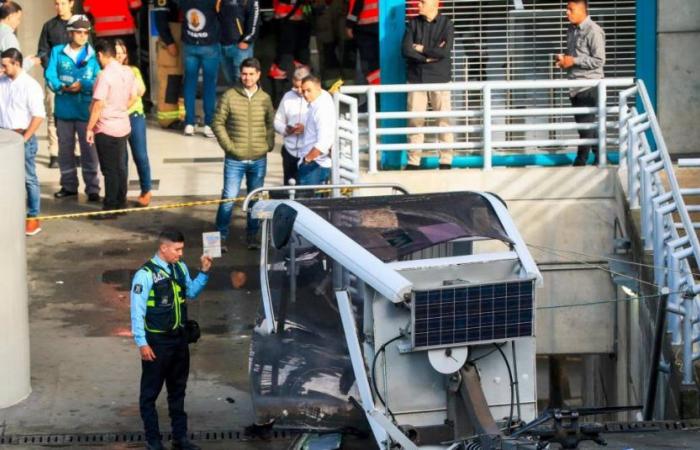08:30 AM
Perhaps the most common unfounded fear in Medellín was that one day a metrocable cabin would fall. Unfounded because even though it swayed like a leaf a couple of times in the middle of untimely downpours, it stopped in the middle of the operation with the cabins full due to some new development and even suffered 13 years ago from the indolence of the urban conflict afterwards. After several cabins were shot at in the middle of the war between combos of commune 13, it was the only mode of the department’s transportation system that in its entire time of operation, 20 years, had never recorded an accident, but in the early morning of Yesterday that changed.
The tragedy occurred at approximately 4:30 am. Just the first minutes of another day of commercial operation had passed when a roar shook the sleep of the residents of the station in the El Popular neighborhood. According to the neighbors and confirmed by the Metro manager, Tomás Elejalde, the accident occurred after one of the cable cars descending from Santo Domingo crashed into another cabin that was leaving the platform and suddenly she broke away from the cable that held her and rushed into the station square.
According to David Muñoz, who lives in a house located a few blocks from the station, when the neighbors went out to see what had happened they found an unexpected image: The cabin was destroyed on the pavement and only screams of despair could be heard. and hands asking for help.
Instinctively, People gathered trying to help the injured, But according to Muñoz, he ran to ask them not to touch them and to call the emergency services, to ask for help because they did not know what condition the injured were in and it could be counterproductive to move them.
So the neighbors got busy trying to tie up the cabin so that it would stop moving and cordon off the place to facilitate the work of emergency agencies They arrived in a matter of minutes.
The director of Dagrd, Carlos Quintero, assured that thanks to the fact that the company designed a response protocol for cabin falls in its risk management plan several years ago, it was possible to mobilize emergency teams in a matter of minutes. After receiving the call at 4:42 amthe Dagrd managed to send a first team made up of firefighters and the Ministry of Health that arrived at the scene at 4:57 am
There were ten passengers in the damaged cabin, all of whom suffered serious injuries. But the worst part was Jhon Jairo Londoño Arango, a 55-year-old man, who was transferred to the CES Clinic with severe trauma to his chest and a fractured tibia. However, after resuscitation attempts, the father of three children died.
Find out: Personería will also open an investigation to establish responsibilities for a fatal accident on the metrocable
Friends and family of John Jairo recounted with pain the minutes that preceded the accident. “I was still lying down when they called me and told me that they were taking him to the CES clinic. I was already going to come when they told me that he had died. He was a good father, a worker, with years in a company in which they categorized him as excellent,” lamented one of the victim’s relatives.
The friend said that Londoño was a resident of the Santo Domingo El Pinar neighborhood and used to leave for work around 3:30 am. He was one of the first neighbors to line up to ride the metrocable and arrive at work before 5:00 am
Manager Tomás Elejalde, who mourned Londoño’s death, had also previously reported that the man was a frequent user of the transportation system, which he took daily to go to work in the Niquía sector, in Bello.
“Unfortunately, that happened to him and the others who were there. Very sad what has happened at this moment“Londoño’s close friend added, specifying that his family is in mourning, since he was responsible for the care of two girls.
As confirmed by the Dagrd during the day, in total he served 29 peoplesince the impact was so strong that the elements that fell from the cabin affected several people who were walking around the place.
Nearly 250 people experienced moments of anxiety aboard the cabins that were suspended for several minutes after complete interruption of service. Fortunately, as reported by Elejalde, the evacuation was carried out without major setbacks, which in the process gave them some clues as they confirmed that the cable was in perfect condition and did not present any damage.
The doubts surrounding the case
Still stunned by the unusual and tragic accident, what all citizens are wondering is what caused the collision between cabins in a system that until yesterday seemed infallible.
Although he said that the entity does not rule out any hypothesis, Elejalde It did largely rule out that the accident was caused by lack of maintenance.. According to the manager, precisely a month and a half ago this line (K) had received maintenance and last year the cable replacement had been brought forward.
But the truth so far is that there is no certainty about what happened. What the company did claim to be clear about is that there is no type of commitment in the rest of the metrocable lines and that their operation continues to be guaranteed.
The manager pointed out that now will begin a rigorous investigation in which both the team of Metro engineers, the local academy and a team of international experts will participate so that, independently, they carry out a thorough investigation that will allow us to know with complete certainty what caused the tragedy.
He anticipated that finding systems in the world on which to base their functioning to contrast their analyzes in the search for the specific failure that caused the accident could be complex, Well, this cable car system is not very common.
Pilar Calvo, a transportation safety expert at the Spanish firm ESM, and who was in charge of the investigations into the Santiago de Compostela railway accident, when a train derailed in July 2013 and left 80 dead, maintained that it is important that the citizens to be clear as a starting point in this research that Zero risk does not exist in any mass transportation system.
According to Calvo, what must now be evaluated is the risk management capacity of the system, and in that sense the audits – as he said – have so far found that The Metro has high standards of risk management protocols.
You may be interested in: “We cannot rule out any hypothesis”: Metro manager talks about investigations into the accident on the metrocable
The expert also valued the company’s response capacity in coordination with emergency agencies to care for the people who were injured. She said that focusing on victims is one of the two fronts that the company now has and that the other is the rigorous research that will have to be led.
Calvo made a specific call for Do not pressure the Metro to deliver hasty hypotheses that could hinder the investigation that began yesterday, and that they must guarantee – he stressed – that an episode like this does not occur again in the system.
He also called for the solidarity of citizens so that they understand the seriousness of the situation and Avoid trivializing with memes the tragedy that mourns a family todaywhich has a community in anxiety and has an entire company mobilizing all its technical and human resources to be able to find the causes of the accident in the shortest possible time.
On the other hand, both the Ministry of Transportation and the Personería of Medellín They announced investigations to advance inspection actionssurveillance and control to which the mass transportation company will be subjected during the time that the investigations last.
It is estimated to be two weeks
The company initially announced that there was no date set for the resumption of commercial operation of line K, until the reasons for the tragedy were clear, but in the last few hours it announced that It could take two weeks to reopen.
That’s why since yesterday The metropolitan mobility contingency plan was activatedwhose objective is to mitigate the damage that will be caused by the indefinite closure of line K.
So as an alternative to public transportation for citizens, The Metro and the Metropolitan Area provided the following five routes: C6-017 that will integrate Acevedo and Santo Domingo and will run through the Santo Domingo station, main road to 97th Street, Granizal, Santa Cruz and Los Balsos neighborhoods, Acevedo; route C6-012A La Francia – Acevedo will leave from the header in La Francia, pass through the Andalucía station and connect with Acevedo; Route C6-013 will connect Popular No. 1, to integrate the Popular station and will reach the Tricentenario station; and Route C6-016 will leave the Hospital station on the southeast side and will support the Granizal and Nuevo Horizonte sectors. In addition, route C6-021 will begin at the Tricentenario station as support to Granizal and Popular 1.
Although the fear is understandable, the company asked citizens for peace of mind and confidence in the system. In 20 years, the metrocable lines They have become a milestone of intra-urban transportation in the world. Line K alone, not counting the operation of the remaining five, moves 50,000 passengers a day, it is the busiest cable in the city and in two decades of operation it has moved more than 200 million users safely, to the point that seven of the large capitals of Latin America such as Mexico City and Rio de Janeiro decided to replicate this model as an advance in more equitable mobility for their inhabitants.






